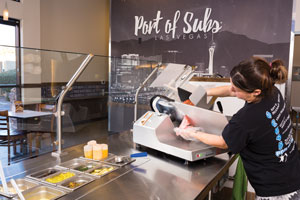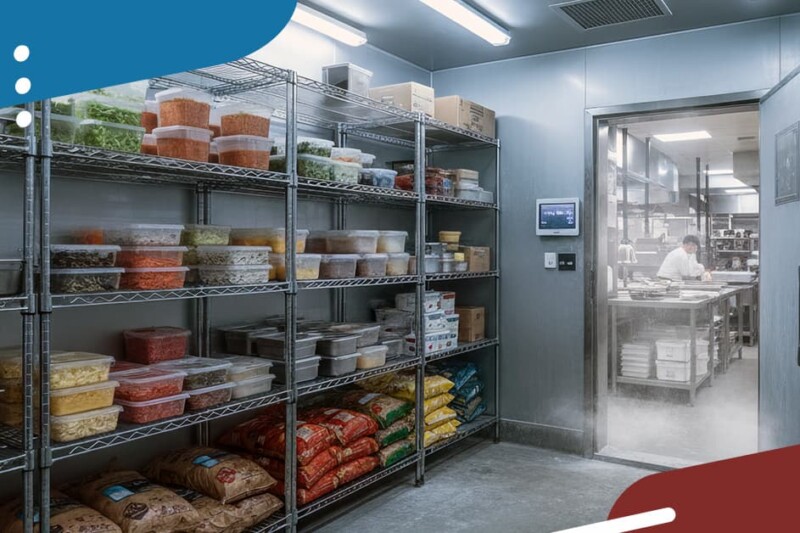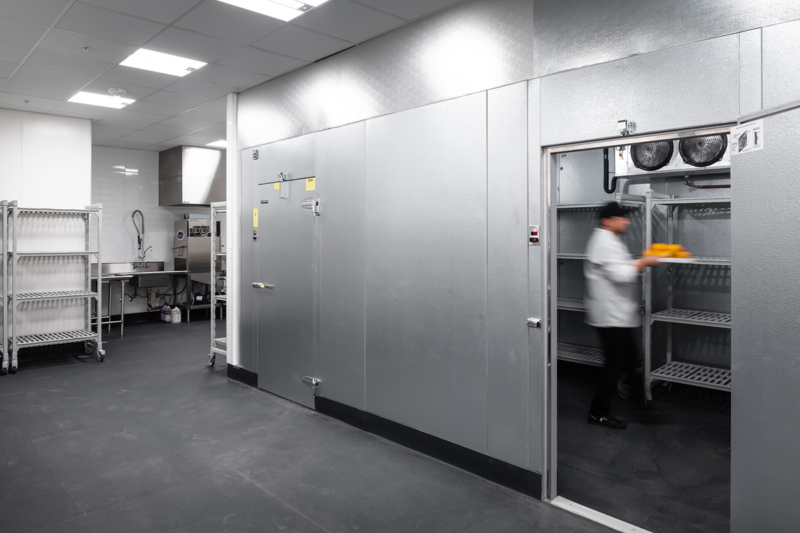
Your chefs or kitchen prep employees may have a favorite knife for jobs around the kitchen, but for consistent, fast slicing of meats, cheeses, vegetables and more, nothing’s more utilitarian than a slicer.
Most visible in delis or sandwich shops, slicers often find their way into kitchens of every stripe due to their surprising versatility. Able to slice in thicknesses ranging from paper-thin to more than an inch thick, slicers can quickly lay out thick cuts of cold roast beef or delicate shavings of prosciutto time after time.
Look at any online equipment catalog or in a dealer showroom, however, and you’ll see an amazing variety of slicers from a dozen or more manufacturers (domestically available). So, how do you choose? As with most equipment picks, it comes down to your menu—essentially, what types of products do you plan to slice, and in what volume?
The Breakdown
In basic terms, there are three types of slicers—manual, semi-automatic and automatic. They come in two formats, vertical and gravity feed. And most manufacturers build models in three versions—light duty, medium duty and heavy duty.
Depending on features, makers also may offer economy and premium versions of each model. (Don’t panic; choosing a slicer is kind of like shopping for a car. Once you figure out size and power, you decide what options and/or accessories you want.)
Manual slicers, as the label implies, operate on old-fashioned elbow grease. Product sits on a carriage that employees manually push past the rotating blade or knife. (Some manufacturers call it a “blade” and some call it a “knife.” Either is correct.)
Semi-automatic slicers can be operated manually, but you also can set slice thickness, carriage speed, and stroke length to accommodate different types and sizes of food products, and let the slicer run on its own.
Fully automatic slicers can be programmed to slice a specific number of slices, and place them on a belt or tray in a certain pattern, such as shingling slices of cheese for packaging or use on a deli tray. These are typically high-volume machines used by food processors. Foodservice applications are more limited—supermarkets, central commissaries, high-volume resort or casino hotels— so we’ll concentrate here on manual and semi-automatic slicers.
Vertical slicers position the blade vertically. Often referred to as meat slicers, larger models can slice raw meat as well as deli meats and cheeses. Smaller models are almost always manual, with the advantage that they take up less counter space, so can be used in smaller operations. Larger models are typically semi-automatic.
Gravity-feed slicers position the carriage and blade at a 25°, 35°, 40°, 45° or 50° angle depending on the model. A higher angle can optimize the weight of the product, helping it slide toward the knife, making semi-automatic operation possible and manual operation easier on employees.
Duty-Bound
Light-duty slicers are perfectly adequate for smaller operations or those that need a slicer only intermittently during the day, such as slicing ham steaks for breakfast and some deli meats for lunch. Note, you can use a light-duty for occasional cheese slicing, but their lighter-hp motor is not designed for regular cheese slicing. In general, light duties are intended for about 30 min. to 120 min. of use a day at most, and typically have ¼-hp motors and smaller blade diameters of 9 in. or 10 in.
Medium-duty slicers work well in restaurants and smaller delis and sandwich shops. They’re built to operate from about two to four hours a day, and usually have blade diameters in the 11-in. to 12-in. range. Motors typically are either 1⁄3 hp or ½ hp.
Heavy-duty slicers have ½-hp motors and are designed to run all day (some up to about eight hours, others up to 12 and even more). One manufacturer no longer rates its slicer by horsepower because it uses a variable frequency drive, adapting the performance to the resistance of the product, which it says is a green benefit with reduction in energy use. You’ll usually find heavy-duty slicers in large restaurants, medium to large delis including supermarkets, multiunit chain operations and hotels. Blade diameters typically run 12 in. to 13 in., but can be as large as 14 in.
Horsepower isn’t the only factor in determining whether or not a slicer can perform all day and with all types of products. Torque is what delivers power to the blade, which in turn helps it cut through product, especially difficult-to-slice foods like semi-soft cheese. Similar models with the same ½-hp motors, from the same maker, for example, may perform differently, with one designed for eight hours of continuous use, the other for 12 or more.
Drive type also may be a factor, but is much less likely these days. Slicers use either gear drives or belt drives. Some makers used to differentiate their slicer line by using gear drives, as an indicator of higher quality. Today, belt drives reduce vibration and are very reliable and long-lasting (to the point where a maker that staked its reputation on gear drives now uses belt drives in its high-end models).
Stay Sharp
Like any other knife in your kitchen, the sharper the blade or knife on your slicer, the safer it is and the better it performs. Look for the Rockwell rating for knife hardness at the blade’s edge; it typically ranges from 50-62. The higher the number, the longer it holds its edge. Blades (or knives) are cast or stamped from four different materials—high-carbon steel, stainless, chrome-plated carbon steel, and stainless with an alloy edge. Spin-casting has eliminated air bubbles that could cause weakness in blades a decade ago, and “stamped” blades now are laser cut, making them even more precise.
High-carbon steel knives are known for the long-lasting sharpness of their edges, but carbon steel oxidizes and stains, which is why some manufacturers chrome-plate their steel blades at the edge. With repeated sharpening, though, the chrome can wear thin or expose more of the carbon steel near the edge to air and food acids.
Stainless tends to be softer than high-carbon, and may need sharpening more often however, which is why one manufacturer welds a special alloy to the edge of its stainless blades.
Manufacturers recommend sharpening blades “as often as necessary,” which could mean once or even twice a shift for slicers in almost continuous use. If the blade starts breaking or tearing cheese or meat or producing inconsistent slices, it’s time to sharpen the knife. Employees should always inspect the blade for nicks or chips before each shift.
Makers provide virtually all slicers with a sharpener, but may provide them separately with light-duty slicers. A couple of manufacturers have a 360° blade ring-guard for improved food safety and use a remote sharpener on their heavy-duty slicers. Medium- and heavy-duty slicers typically have a sharpener that snaps on the blade guard or is constantly attached to the machine, yet is removable for cleaning.
Sharpeners typically have two stones, one for sharpening, the other for honing or de-burring the blade once it’s sharp. Some sharpeners use composite stones, which are effective but can absorb moisture and shouldn’t be used wet. Others use sharpeners made with more expensive Borazon, an artifically produced crystal that has the hardness of a diamond, and some actually use synthetic diamonds.
Size matters, too. The larger the knife, the easier it slices through product. However, if all you’re slicing are 2-in. pepperoni sticks you don’t need a 14-in. knife. Conversely, you’ll need a large carriage and knife to handle roasts and hams.
Built Like A Brick…
Well, not brick, but you’ll find even light-duty slicers are solidly constructed, and if used according to manufacturers’ recommendations and specs, they’ll all give you years of service.
Changes to NSF/ANSI 8 in 2010 and reflected in the current NSF/ANSI Standard 8-2012, put a focus on food safety. The result was slicers that are easier to clean, with more one-piece construction or smooth seams that can’t trap contaminants like bacteria, and more space between parts, especially between the knife and the body. UL 157-2007 dealing with gaskets and seals, recommends that employees pay special attention to these components to see if there are cracks or chips before they start cleaning.
At the lower end, material used for uni-body construction is typically molded poly. A step up are anodized and burnished aluminum models. Aluminum is easy to mold in one piece, but can stain and pit over time if exposed to acidic foods. Some premium models are constructed of more expensive stainless, which is both durable and attractive, but since it can’t be molded makers have to be careful to make any seams smooth.
More parts now are removable for cleaning in a dishmachine, and a number of makers have added features like tilting carriages for easier cleaning of the machine, and side lift-arm assists so employees can clean the counter under the slicer.
Parts like the gauge plate and knife cover are typically machine-grooved to reduce drag as the carriage pushes product past the blade. One manufacturer incorporates titanium into the plate coating to reduce drag. Another offers an optional non-stick repellent finish that’s resistant to dishmachine chemicals.
Self-Driving Mode
If you’re slicing a lot of product, a semi-automatic slicer can free up your employees to do other tasks while the slicer runs (and take less of a physical toll on them). Different manufacturers offer different features, so take a careful look to see which you really need.
Carriage speed varies from model to model (listed as strokes per minute on spec sheets), as does the number of speeds you can choose from. Some models offer only two speeds while others offer three, four, and even nine speeds.
Stroke length can be adjusted to the size of the product you’re slicing. You don’t need the carriage to move a foot to slice 3-in.-diameter salami. Some models have a few preset stroke lengths. Others let you set a specific length and hold it in memory for about 30 seconds while employees position or replenish product.
Blade speed also can be an important factor. Check the rpms listed; depending on the mode, the knife can spin anywhere between 250 and 380 rpm. Some go higher. Too fast and friction can start to heat the product, a potential problem if you’re cutting sausage or cheese. If you slice a lot of high-fat-content product or cheese, you may want a model that runs at slower rpm. One maker offers a specially grooved blade expressly for slicing cheese.
Note, too, that on models with larger blades the knife edge travels faster than on smaller diameter blades, cutting more product per hour (at the same rpm) and providing more inertia to continue cutting through thicker product.
Slice thickness obviously is adjustable on all slicers, but make sure the slicer you buy has the range of thicknesses you want. As important is how finely thicknesses can be adjusted. While all makers talk about the precision and consistency of their indexing systems, at least one manufacturer has a patent pending on a cam and pin indexing system it says is more precise.
Be Safe Out There
After making slicers safer from a microbiological standpoint after the NSF/ANSI 8-2010 changes, manufacturers have since focused on making them safer for employees to operate. Most of the following safety features have been around a while, but have been added to even medium-duty models. Some are new and improved.
Permanently mounted full knife ring guards. More models now feature a solid 360° ring guard that protects the operator and doesn’t expose the knife edge even when the sharpener is removed.
Thumb guard protection. A thumb guard protects your hand from the operating area and the thumb guard wall ranges from 2 in. to 6 in. wide and in height from 6 in. to 14 in.
Noise control drive system. Some models operate above ~90.0 dB decibel level and as low as ~64.0 dB, the level of a normal conversation.
Knife cover interlocks prevent the slicer from running if the knife cover is removed.
Gauge plate and carriage interlock. This feature prevents tilting or removing the carriage for cleaning when the gauge plate is open and the knife is exposed.
Knife removal tools. More makers provide special tools (patented in some cases) that keep the knife edge covered when employees remove blades for cleaning.
Close to stop. The slicer automatically shuts off when you turn the slice thickness knob to zero or past zero, closing the gauge plate. This also keeps the operator’s hand in a safe-zone and extends the life of the on-off key pad.
Home start position or slice thickness knob position. On some models, employees have to pull the carriage all the way toward them or twist the slice thickness knob past zero before the slicer will start. That keeps their hands away from the blade when the machine is turned on. Some semi-automatic models return the product tray to the start position when you shut off the slicer.
Auto shut-off. A few models automatically shut off the knife motor if the product tray or carriage hasn’t moved for either 10 sec. or 30 sec., which saves energy. One manufacturer lets you adjust shut-off from 15, 30, 45 sec. or lets it run continuously.
Motor burnout protection. A few models have a thermal switch that automatically shuts off the slicer if the motor overheats.
Colored parts for operator safety. Some makers have added color to specific parts to let employees know which areas are safe to touch during operation.
Controls. Most manufacturers have repositioned controls to move them out of the way of food or dripping juices, and angled them for easier access. Controls on higher-end machines also tend to be more intuitive or explanatory. A couple of manufacturers have recently introduced very cool and safe innovations. One is a patented illuminated indexing knob that glows green in safe mode, flashing red to indicate an open carriage, solid red to indicate run mode with open carriage and blade in motion, and is white when the unit is unplugged. Another line has a clear text graphic display that provides operator messages such as settings, slice count, total time turned on, total run time, and instructions in three languages, as well as diagnostics for service techs.
How Much?
Plan on spending about $1,000 for a light-duty manual slicer and double that for a semi-automatic. Heavy-duty manual slicers start around $3,000 and can run up to about $5,000. The same slicer in a semi-automatic version will start around $3,000 to $4,000 and can set you back $8,000 or more for high-end models.
As always, compare warranties and service networks to find a supplier that best fits your needs.
A Slice Of Advice
• Slicers perform best when foods are cold, down around 32°F…
•…but don’t try to slice frozen food with a regular blade. Special serrated blades are designed to cut through frozen food. They require professional sharpening from time to time, but don’t lose their edge as quickly as normal blades.
• Never use vegetable oil to lubricate the carriage slide rod. Friction will turn it into a sticky mess. Use manufacturer-recommended lubricating oil only.
• Put slicers on a stand no more than 31½-in. high, so the product tray is counter height. Setting them on a normal countertop makes them ergonomically uncomfortable for most employees to operate, and outside ADA guidelines.
• Don’t forget accessories. Most manufacturers of heavy-duty slicers offer an optional vegetable hopper or food chute for them, and several offer a slaw tray, too, both of which make the slicer even more versatile.
Old-Country Theater
Wilhelm van Berkel invented the meat slicer in the Netherlands’ Rotterdam in 1898. The hand crank, mounted on a flywheel, turned a gear system that rotated the slicing blade. Utilitarian enough to spread worldwide within a decade, the “volano” (flywheel) as they’re known in Italy, became works of art. Precision machined and razor sharp, they can shave paper-thin slices of prosciutto or Genoa ham.
Today’s trend toward house-made charcuterie and the beauty of these old machines has sparked a renewed interest in them as a form of theater in many operations. Many chefs love working with flywheels, citing that they hit a steady rhythm and the right speed to gently press a jambon or mortadella into the blade for exceptionally thin slices.
While there are still a large number of antique slicers on the market—and several artisan companies that refurbish them—several manufacturers still make them (and not just in Italy). Some have even added electric models to their lines, but for true authenticity, the manual models still sell best.
RELATED CONTENT
- Advertisement -
- Advertisement -
- Advertisement -
TRENDING NOW
- Advertisement -
- Advertisement -
- Advertisement -


